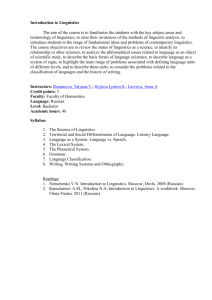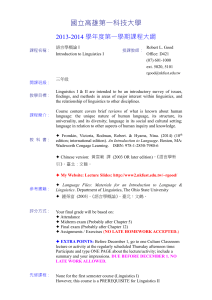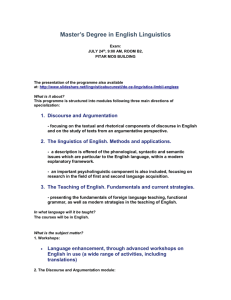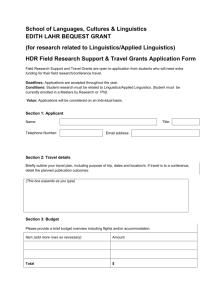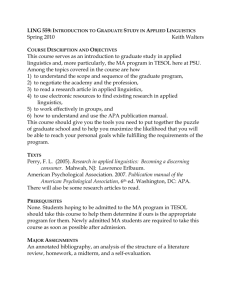introduction to linguistics
advertisement
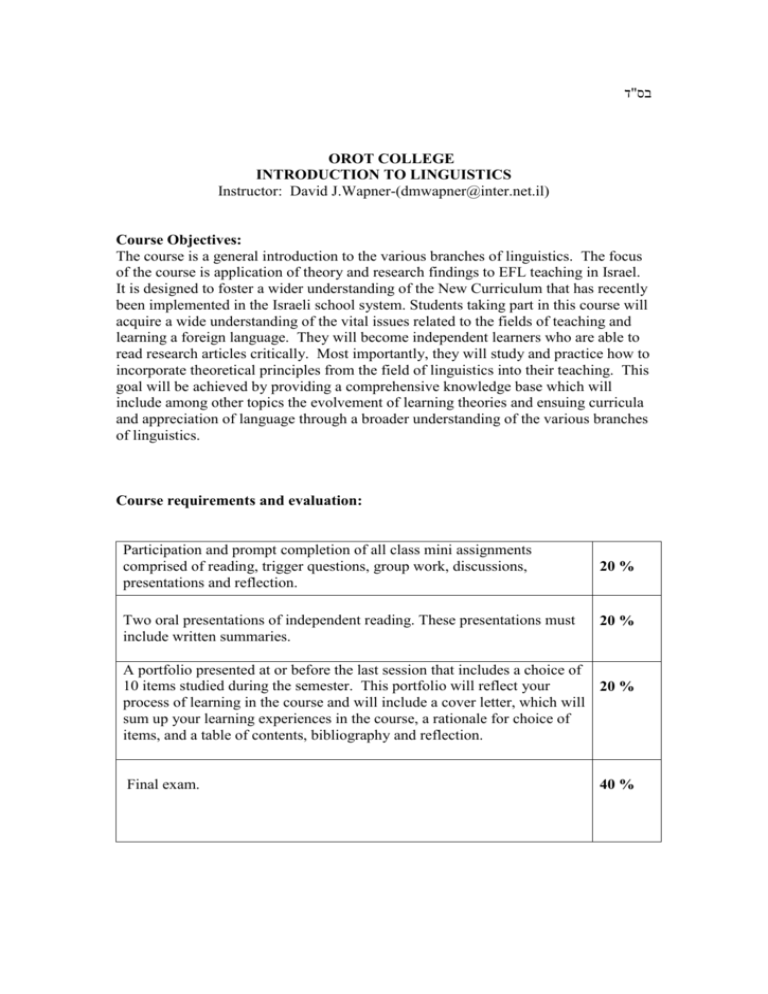
בס"ד OROT COLLEGE INTRODUCTION TO LINGUISTICS Instructor: David J.Wapner-(dmwapner@inter.net.il) Course Objectives: The course is a general introduction to the various branches of linguistics. The focus of the course is application of theory and research findings to EFL teaching in Israel. It is designed to foster a wider understanding of the New Curriculum that has recently been implemented in the Israeli school system. Students taking part in this course will acquire a wide understanding of the vital issues related to the fields of teaching and learning a foreign language. They will become independent learners who are able to read research articles critically. Most importantly, they will study and practice how to incorporate theoretical principles from the field of linguistics into their teaching. This goal will be achieved by providing a comprehensive knowledge base which will include among other topics the evolvement of learning theories and ensuing curricula and appreciation of language through a broader understanding of the various branches of linguistics. Course requirements and evaluation: Participation and prompt completion of all class mini assignments comprised of reading, trigger questions, group work, discussions, presentations and reflection. Two oral presentations of independent reading. These presentations must include written summaries. 20 % 20 % A portfolio presented at or before the last session that includes a choice of 10 items studied during the semester. This portfolio will reflect your 20 % process of learning in the course and will include a cover letter, which will sum up your learning experiences in the course, a rationale for choice of items, and a table of contents, bibliography and reflection. Final exam. 40 % Course of Study Session 1: Introductions Working definitions of linguistics. Readings : Contemporary Linguistics Language preview. Homework to be assigned. Session 2: Methodology – Language Teaching Approaches Readings: Teaching English as ESL or EFL. Homework to be assigned Session 3: Linguistics and Languages Readings: Origins and Development of the English Language. Exploring syntax and lexis Homework to be assigned Session 4: The Bilingual Child Readings: Bilingualism and Second Language Acquisition. Social and Linguistic application Homework to be assigned Session 5: Research on Second Language Acquisition Readings: Linguistic Environment for Language Acquisition. Adjustments in language input and output in Native Language and Target Language Homework to be assigned Session 6: Using Role-play and Socio- Drama in expanding Language. Readings: Teaching for Success in Jewish Religious Schools. Homework to be assigned Session 7: The development of Language. Biological and social factors involved in language acquisition. Readings: Foundation of Dual Language Instruction. Homework to be assigned Session 8: Syntax and Semantics Identifying points of reference and Deducing the Meaning of Words Readings: Build It Up. Homework to be assigned Session 9: Language Measurement. Its purposes, types and evaluation Types of Language testing and reliability. Readings: Language Testing Homework to be assigned Session 10: Teaching English as a Second/Foreign Language through music How music and rhyme increase language retention and acquisition. Readings:Regev-BIU Homework to be assigned Session 11: Varieties within language. Reasons for linguistic registers and appropriate language depending on conditions. Reading: Regev-BIU Homework to be assigned Session 12: Phonetics, the sounds of language. How sounds are produced. Introduction of phonetic alphabets (American and British). Readings: Contemporary Linguistics Homework to be assigned Session 13: Potpourri. No Homework Session 14: Review Session. Be’hatzlacha I wish you an enjoyable course! Bibliography for Introduction to Linguistics and Applied Linguistics. Bee, Helen, 1999. The Developing Child. New York: Harper Collins. Benesh, Sarah, 1998. ESL in America. Myths and Possibilities. Portsmouth, NH: Boynton/Cook Publishers. Celce- Murcia, Marianne, 2001. Teaching English as a Second or Foreign Language. Boston, MA: Heinle and Heinle Publishers. Duckworth, Eleanor, 1996. The Having of Wonderful Ideas and Other Essays on Teaching and Learning. New York: Teachers College Press. Davies, Alan, 1990. Principles of Language Testing. Cambridge, MA: Basil Blackwell. Grosjean, Francois, 1990. Life with Two Languages. Cambridge, MA: Harvard University Press. Grant, Henning, 1987. Guide to Language Testing. Boston, MA: Heinle and Heinle Pub. Herman, Dorothy C., 1993. Teaching for Success. Los Angeles, CA: Torah Aura Productions. Heward, William, 2002. Exceptional Children. Kayfetz, Janet L., Michaele E. F. Smith, 1996. Boston: Heinle and Heinle Publishers. Ladefoged, Peter, 2000. A Course in Phonetics. Boston: Allyn and Bacon. Speaking Effectively. New York: St. Martin’s Press. Larssen-Freeman, Diane, Michael Long, 1991. An Instruction to Second Language Acquisition Research. London: Longman. Lessow-Hurley, Judith,2004. The Foundations of Dual Language Instruction. New York, Longman. Mussen, Paul Henry, John Janeway Conger, Jerome Kagan, Aletha Carol Huston, 1990. Child Development and Personality. New York: Harper Collins. O’Grady, William, Janie Rees-Miller, Mark Aronoff, John Archibald, 2004. Contemporary Linguistics. New York: St. Martin’s Press. Parkay, Forrest W., Beverly Hardcastle Stanford, 2003. Boston: Allyn and Bacon. Becoming a Teacher. Pyles, Thomas, 2004. The Origins and Development of the English Language. Fort Worth, Texas: Harcourt Brace Jonanovich College Publishers. Roe, B.D., P.C. Burns and S.H. Smith, 2004. Teaching Reading in Today’s Elementary Schools Princeton, New Jersey: Houghton Mifflin Co. Rubin, Dorothy, 1992. A Practical Approach to Teaching Reading. Boston: Allyn and Bacon. Snowman, Jack, Rovert F.Biehler, 2005. Houghton Mifflin Company. Psychology Applied to Teaching.Boston:



